Dalībnieks:Japets/Smilšu kaste
| Regulārs Ikosaedrs | |
|---|---|
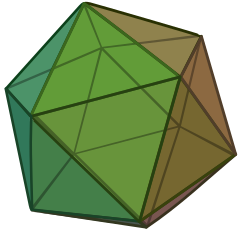 (Spied šeit, lai aplūkotu rotējošu modeli) | |
| Tips | Platona daudzskaldnis |
| Elementi | F = 20, E = 30 V = 12 (χ = 2) |
| Skaldņu skaits pēc malām | 20{3} |
| Šlēfli simbols | {3,5} and s{3,3} |
| Vithofa simbols | 5 | 2 3 | 3 3 2 |
| Koksetera-Dinkina diagramma | |
| Simetrijas | Ih un Td vai (*532) un (332) |
| Atsauces | U22, C25, W4 |
| Īpašības | Regulārs izliekts deltahedron |
| Divplakņu leņķis | 138.189685° |
 3.3.3.3.3 (Virsotnes figūra) |
 Dodekaedrs (duālais daudzskaldnis) |
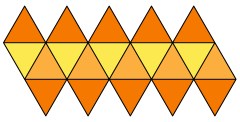 Izklājums | |
Ģeometrija, ar ikosaedru (Veidne:Lang-el, no eikosi divdesmit + hedron vietas; /ˌaɪ.kəʊ.sə.ˈhi.dɹən/; plural: -drons, -dra /-dɹə/) ir jebkurš daudzskaldnis ar 20 skaldnēm, bet parasti ar to saprot tieši regulāru ikosaedru, kuram skaldnes ir regulāri trīsstūri.
Regulārs ikosaedrs ir viens no pieciem Platona daudzskaldņiem. Tas ir izliekts, regulārs daudzskaldnis, kuram ir divdesmit trīsstūrveida skaldnes, kuras pa piecām satiekas katrā virsotnē. Tam ir 30 šķautnes un 12 virsotnes. Tā duālais daudzskaldnis ir dodekaedrs.
Izmēri
[labot šo sadaļu | labot pirmkodu]Ja regulāra ikosaedra malas garums ir , tad apvilktās sfēras (tās, kura pieskaras visām ikosaedra virsotnēm) rādiuss ir
un ievilktās sfēras (pieskarās katrai ikosaedra skaldnei) rādiuss ir
, un viduslīniju sfēras rādiuss, kura pieskaras katras šķautnes viduspunktam, ir
, kur (tiek apzīmēts arī ar ) ir zelta šķēlums.
Laukums un tipums
[labot šo sadaļu | labot pirmkodu]Regulāra ikosaedra ar šķautnes garumu a virsmas laukums A un tilpums V ir:
- .
Dekarta koordinātas
[labot šo sadaļu | labot pirmkodu]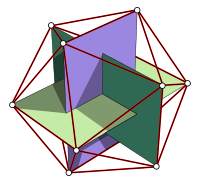
Sekojošās Dekarta koordinātas uzrāda ikosaedra ar šķautnes garumu 2 virsotnes attiecībā pret centru:
- (0, ±1, ±φ)
- (±1, ±φ, 0)
- (±φ, 0, ±1)
kur φ = (1+√5)/2 ir zelta šķēlums (tiek apzīmēts arī ar τ). Note that these vertices form five sets of three mutually centered, mutually orthogonal golden rectangles.
Regulāra oktaedra 12 šķautnes var sadalīt ar zelta šķēlumu tā, ka rezultātā iegūtās virsotnes veido regulāru ikosaedru. This is done by first placing vectors along the octahedron's edges such that each face is bounded by a cycle, then similarly partitioning each edge into the golden mean along the direction of its vector. The five octahedra defining any given icosahedron form a regular polyhedral compound, as do the two icosahedra that can be defined in this way from any given octahedron.
Construction by a system of equiangular lines
[labot šo sadaļu | labot pirmkodu]The following construction of the icoshaedron avoids tedious computations in the number field necessary in more elementary approaches.
Existence of the icosahedron amounts to the existence of six equiangular lines in . Indeed, intersecting such a system of equiangular lines with an Euclidean sphere centered at their common intersection yields the twelve vertices of a regular icosahedron as can easily be checked. Conversely, supposing the existence of a regular icosahedron, lines defined by its six pairs of opposite vertices form an equiangular system.
In order to construct such an equiangular system, we start with the matrix
of square size . (Mnemonic: the matrix encodes the angles, acute for a positive entry, obtuse otherwise, between five cyclically consecutive vertices adjacent to a first vertex of an icosahedron centered at the origin.)
A straightforward computation yields . This implies that has eigenvalues and , both with multiplicity since is symmetric and of trace zero. The matrix induces thus an Euclidean structure on the quotient space which is isomorphic to since the kernel of has dimension . The image under the projection of the six coordinate axes in forms thus a system of six equiangular lines in intersecting pairwise at a common acute angle of . Orthogonal projection of onto the -eigenspace of yields thus the twelve vertices of the icosahedron.
A second straightforward construction of the icosahedron uses representation theory of the alternating group acting by direct isometries on the icosahedron.
Stellations
[labot šo sadaļu | labot pirmkodu]According to specific rules defined in the book The fifty nine icosahedra, 59 stellations were identified for the regular icosahedron. The first form is the icosahedron itself. One is a regular Kepler-Poinsot solid. Three are regular compound polyhedra. [1]
 The faces of the icosahedron extended outwards as planes intersect, defining regions in space as shown by this stellation diagram of the intersections in a single plane. |

|

|

|

|

|

|
||

|

|

|

| |||||

|

|

|

|
Geometric relations
[labot šo sadaļu | labot pirmkodu] Icosahedron as a snub tetrahedron. |
 Icosahedron as an alternated truncated octahedron. |
There are distortions of the icosahedron that, while no longer regular, are nevertheless vertex-uniform. These are invariant under the same rotations as the tetrahedron, and are somewhat analogous to the snub cube and snub dodecahedron, including some forms which are chiral and some with Th-symmetry, i.e. have different planes of symmetry from the tetrahedron. The icosahedron has a large number of stellations, including one of the Kepler-Poinsot polyhedra and some of the regular compounds, which could be discussed here.
The icosahedron is unique among the Platonic solids in possessing a dihedral angle not less than 120°. Its dihedral angle is approximately 138.19°. Thus, just as hexagons have angles not less than 120° and cannot be used as the faces of a convex regular polyhedron because such a construction would not meet the requirement that at least three faces meet at a vertex and leave a positive defect for folding in three dimensions, icosahedra cannot be used as the cells of a convex regular polychoron because, similarly, at least three cells must meet at an edge and leave a positive defect for folding in four dimensions (in general for a convex polytope in n dimensions, at least three facets must meet at a peak and leave a positive defect for folding in n-space). However, when combined with suitable cells having smaller dihedral angles, icosahedra can be used as cells in semi-regular polychora (for example the snub 24-cell), just as hexagons can be used as faces in semi-regular polyhedra (for example the truncated icosahedron). Finally, non-convex polytopes do not carry the same strict requirements as convex polytopes, and icosahedra are indeed the cells of the icosahedral 120-cell, one of the ten non-convex regular polychora.
An icosahedron can also be called a gyroelongated pentagonal bipyramid. It can be decomposed into a gyroelongated pentagonal pyramid and a pentagonal pyramid or into a pentagonal antiprism and two equal pentagonal pyramids.
The icosahedron can also be called a snub tetrahedron, as snubification of a regular tetrahedron gives a regular icosahedron. Alternatively, using the nomenclature for snub polyhedra that refers to a snub cube as a snub cuboctahedron (cuboctahedron = rectified cube) and a snub dodecahedron as a snub icosidodecahedron (icosidodecahedron = rectified dodecahedron), one may call the icosahedron the snub octahedron (octahedron = rectified tetrahedron).
A rectified icosahedron forms an icosidodecahedron.
Icosahedron vs dodecahedron
[labot šo sadaļu | labot pirmkodu]When an icosahedron is inscribed in a sphere, it occupies less of the sphere's volume (60.54%) than a dodecahedron inscribed in the same sphere (66.49%).
Also, as these are duals, it is possible to transform one into the other(See below).
 Icosahedron |
 Truncated icosahedron |
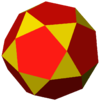 Icosidodecahedron |
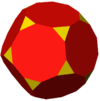 Truncated dodecahedron |
 Dodecahedron |
Uses and natural forms
[labot šo sadaļu | labot pirmkodu]|
Many viruses, e.g. herpes virus, have the shape of an icosahedron. Viral structures are built of repeated identical protein subunits and the icosahedron is the easiest shape to assemble using these subunits. A regular polyhedron is used because it can be built from a single basic unit protein used over and over again; this saves space in the viral genome. | |
In 1904, Ernst Haeckel described a number of species of Radiolaria, including Circogonia icosahedra, whose skeleton is shaped like a regular icosahedron. A copy of Haeckel's illustration for this radiolarian appears in the article on regular polyhedra.
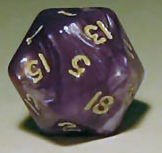 |
In some roleplaying games, the twenty-sided die (for short, d20) is used in determining success or failure of an action. This die is in the form of a regular icosahedron. It may be numbered from "0" to "9" twice (in which form it usually serves as a ten-sided die, or d10), but most modern versions are labeled from "1" to "20". See d20 System. |
An icosahedron is the three-dimensional game board for Icosagame, formerly known as the Ico Crystal Game.
An icosahedron is used in the board game Scattergories to choose a letter of the alphabet. Six little-used letters, such as X, Q, and Z, are omitted.
Inside a Magic 8-Ball, various answers to yes-no questions are printed on a regular icosahedron.
The icosahedron displayed in a functional form is seen in the Sol de la Flor light shade. The rosette formed by the overlapping pieces show a resemblance to the Frangipani flower.
If each edge of an icosahedron is replaced by a one ohm resistor, the resistance between opposite vertices is 0.5 ohms, and that between adjacent vertices 11/30 ohms.[2]
The symmetry group of the icosahedron is isomorphic to the alternating group on five letters. This nonabelian simple group is the only nontrivial normal subgroup of the symmetric group on five letters. Since the Galois group of the general quintic equation is isomorphic to the symmetric group on five letters, and the fact that the icosahedral group is simple and nonabelian means that quintic equations need not have a solution in radicals. The proof of the Abel-Ruffini theorem uses this simple fact, and Felix Klein wrote a book that made use of the theory of icosahedral symmetries to derive an analytical solution to the general quintic equation.
See also
[labot šo sadaļu | labot pirmkodu]- Truncated icosahedron
- Regular polyhedron
- Geodesic grids use an iteratively bisected icosahedron to generate grids on a sphere
- Jessen's icosahedron
References
[labot šo sadaļu | labot pirmkodu]- ↑ Coxeter, Harold Scott MacDonald; Du Val, P.; Flather, H. T.; Petrie, J. F. (1999), The fifty-nine icosahedra (3rd izd.), Tarquin, ISBN 978-1-899618-32-3, MR676126 (1st Edn University of Toronto (1938))
- ↑ Klein, Douglas J. (2002). "Resistance-Distance Sum Rules" (PDF). Croatica Chemica Acta 75 (2): 633–649. Atjaunināts: 2006-09-15.
External links
[labot šo sadaļu | labot pirmkodu]| Vikikrātuvē par šo tēmu ir pieejami multivides faili. Skatīt: Icosahedron |
- Veidne:Mathworld
- Paper models of the icosahedron
- The Uniform Polyhedra
- K.J.M. MacLean, A Geometric Analysis of the Five Platonic Solids and Other Semi-Regular Polyhedra
- Interactive Icosahedron model - works right in your web browser
- Virtual Reality Polyhedra The Encyclopedia of Polyhedra
- Tulane.edu A discussion of viral structure and the icosahedron
- Paper Models of Polyhedra Many links
- Origami Polyhedra - Models made with Modular Origami
- video of icosahedral mirror sculpture









![{\displaystyle \mathbb {Q} [{\sqrt {5}}]}](https://wikimedia.org/api/rest_v1/media/math/render/svg/5691f5e84ebcf23acbd458f90f57c0945549be8c)


















